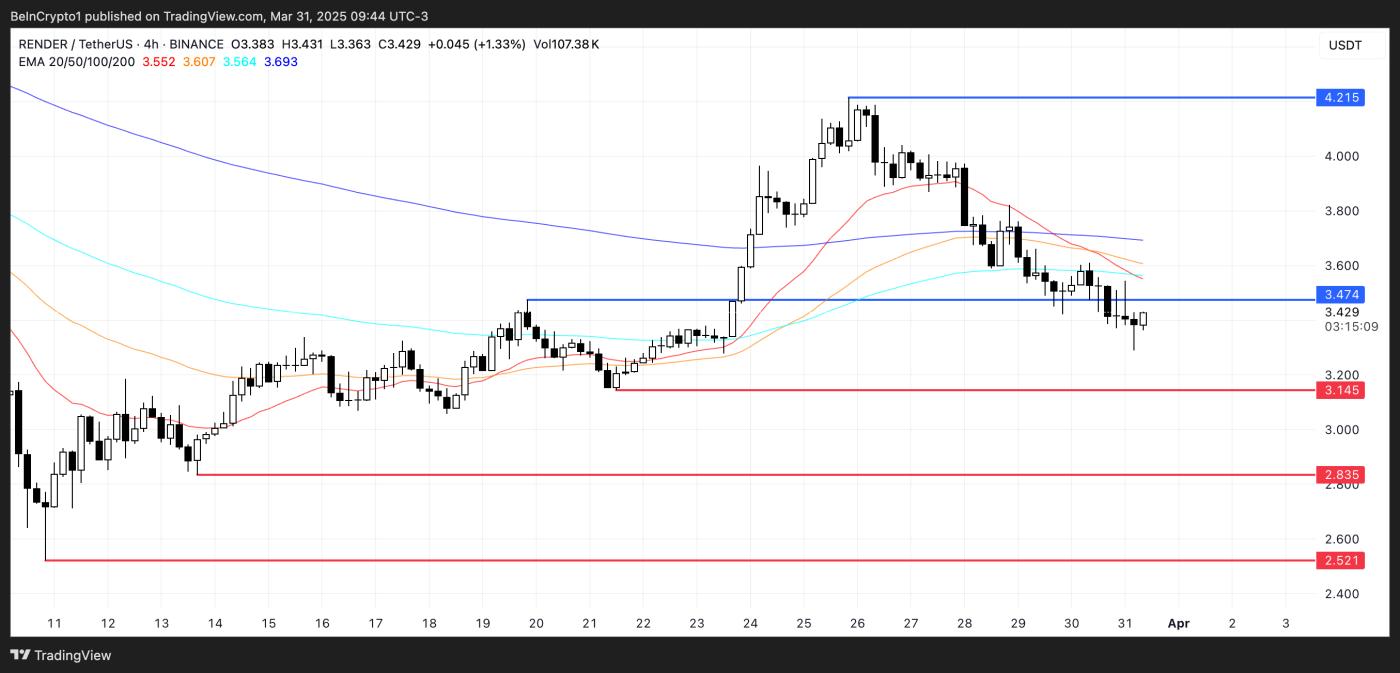US-produced cryptocurrencies continue to attempt recovery, with Solana (SOL), RENDER, and Jupiter (JUP) standing out as notable names in April. Despite recent price adjustments, each token plays a crucial role in high-growth areas such as DeFi, AI, and blockchain infrastructure.
Solana has experienced price declines, but ecosystem activity remains strong; RENDER is benefiting from AI demand despite market volatility; and Jupiter is showing stable usage metrics even as its token faces challenges. Below is a more detailed look at the technical and fundamental setups for each of these prominent US-based projects.
Solana (SOL)
Solana has faced significant price adjustment over the past week, with values dropping nearly 13%. If this downward trend continues, the token may be on track to retest a critical support level at $120.
A break below that could cause SOL to slide further to $112.
 SOL Price Analysis. Source: TradingView.
SOL Price Analysis. Source: TradingView.Despite recent declines, Solana remains one of the most relevant US-produced coins and continues to show impressive usage metrics. For example, PumpFun generated nearly $9 million in revenue in the past 24 hours, second only to Tether.
After a brief period when BNB led the DEX volume race, Solana seems to be regaining momentum—its decentralized exchange trading volume increased 128% in just seven days, reaching $18 billion and surpassing both Ethereum and BNB.
If this momentum recovery continues, SOL could aim to move towards the resistance level of $131. A successful breakout there could open opportunities for further gains towards $136 and potentially $147.
Render
RENDER, one of the most prominent US-based cryptocurrencies focused on artificial intelligence, has seen prices drop nearly 11% over the past seven days.
This decline reflects a broader adjustment that has affected many AI-related tokens in recent months.
However, new developments in the AI infrastructure space could provide momentum for a potential recovery, especially as the limitations of centralized systems become apparent.
 RENDER Price Analysis. Source: TradingView.
RENDER Price Analysis. Source: TradingView.Tory Green, CEO of leading global GPU provider io.net, told BeInCrypto: "The recent surge in demand for OpenAI's services after its new image generation capability release once again highlighted that these large AI players are simply not prepared to handle the surge in demand. Melting GPUs is not a sustainable way to handle traffic, and it's not feasible for OpenAI and others to quickly enhance their processing base."
He argued that AI centralization is a major issue, with decentralized solutions being an excellent option to activate additional resources.
If the upward momentum returns in the AI sector, RENDER could aim to challenge the resistance at $3.47, and a successful breakout could open opportunities for a price increase towards $4.21.
However, if the current adjustment goes deeper, the token could drop to test the support level of $3.14. A break there could trigger additional losses, potentially pulling RENDER down to $2.83 or even $2.52—the lowest level in recent weeks.
Jupiter (JUP)
Despite Solana's recent difficulties, Jupiter—its leading DEX aggregator—is showing impressive operational strength.
In the past 24 hours, Jupiter ranked as the fourth-highest protocol in cryptocurrency by fee generation, earning nearly $2.5 million.
Only Tether, PumpFun, and Circle surpassed it, emphasizing the platform's growing relevance in the Solana ecosystem even during weaker market periods.
 JUP Price Analysis. Source: TradingView.
JUP Price Analysis. Source: TradingView.However, JUP, Jupiter's native token, does not reflect this positive momentum. Its price has dropped over 21% in the past week, becoming one of the worst-performing Made in USA coins. It has remained below $0.65 for three consecutive weeks.
With JUP currently hovering dangerously near the critical support level of $0.44, a break could cause the token to drop below $0.40 for the first time in its history.
However, if market sentiment changes and momentum returns, JUP could begin climbing again—first testing resistance at $0.54, then potentially advancing to $0.598 and even $0.63 if buying pressure increases significantly.






